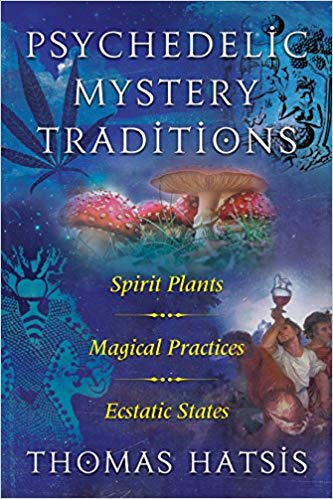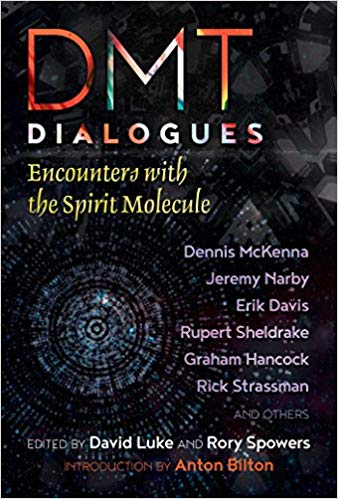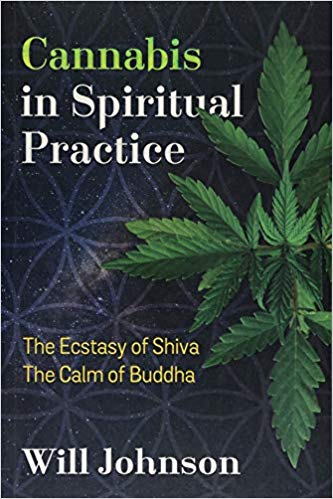TWH – When psychonaut Stephen Gray writes “What a long, strange trip it’s been,” he’s playfully referencing that Grateful Dead album with the same title.
But Gray is after bigger game: The “trip” he’s actually citing is humankind’s “incredibly rich history of plant-entangled religion and magic,” as he writes in the forward to the book Psychedelic Mystery Traditions: Spirit Plants, Magical Practices, Ecstatic States by Thomas Hatsis.
For Pagans who refer to their practice as an “earth-based spirituality” or “nature spirituality” (see circlesanctuary.org), those terms can carry various meanings. For Pagans whose paths include entheogens, “earth-based” is a very literal term.
The website oxforddictionaries.com defines entheogen as “a chemical substance, typically of plant origin, that is ingested to produce a non-ordinary state of consciousness for religious or spiritual purposes.” The term dates only to the 1970s, and its Greek roots literally mean “becoming divine within.”
The Oxford site reports the word was “coined by an informal committee studying the inebriants of shamans.”
A psychonaut, by the way, is someone who explores altered states of consciousness — especially but not always through hallucinogens — for spiritual or scientific purposes.
Clinical psychiatrist Jan Dirk Blom defines “psychonautics” as “the exploration of the psyche by means of techniques such as lucid dreaming, brainwave entrainment, sensory deprivation, and the use of hallucinogens or entheogens.”
Are we in the midst of an entheogenic renaissance? The number of books published on entheogens in recent years suggests so. Here’s a look at three recently published works.

Psychedelic Mystery Traditions: Spirit Plants, Magical Practices, Ecstatic States by Thomas Hatsis, forward by Stephen Gray. Park Street Press, 272 p.
Hatsis wanders across time, space, and cultures in his exploration of how psychedelics and entheogens have been used in magic and religion in Western civilization, from the Neolithic era to modern times.
He casts his gaze upon Neolithic art depicting mushroom-eating shamans, the Eleusinian mysteries of ancient Greece, Gnostics, “primitive Christian psychedelia,” psychedelics and the “sacred marriage,” fairy ointments and goddess worship, “Christianizing Pagan psychedelia,” the development of the “satanic witch stereotype” by Christian theologians in the 1400s, Renaissance ceremonial magic, Sufi alchemists in the ancient Middle East, Aleister Crowley, and more – concluding with the assertion that “today we live in the warm embrace of the psychedelic renaissance.”
Though amply footnoted and with a sizable bibliography, this isn’t a dry, academic tome. Hatsis writes in a lively, conversational style: “A person can use a pharmakon (drug) like cannabis as an entheogen – I certainly do! – but some troll sitting in his mom’s basement smoking a bong acting like an asshole on the internet isn’t having an entheogenic experience by my logic . . . . There is no entheogen without intention.”
And: “Material reductionists use psychedelics every bit as much as your weird, witchy, tree-hugging, Gaia-worshipping friend does.”
Hatsis also isn’t afraid to coin a word – or many. He defines a number of them in his opening chapter. “Somnitheogen” is his term for “any psychedelic used to cast a person into a deep but lucid dream state so as to commune with otherworldly beings.” “Poetigen” is a “psychedelic that unlocks the creative spirit.” “Extheogen” means “generating spiritual entities outside the self.” “Pythiagen” is a “psychedelic used for magical purposes.”
Hatsis’ book is, to borrow a phrase, quite a trip.

* DMT Dialogues: Encounters with the Spirit Molecule, edited by David Luke and Rory Spowers, introduction by Anton Bilton. Park Street Press, 336 p.
Those who ingest DMT (dimethyltryptamine), a hallucinogenic naturally occurring in an Amazonian plant and often served in a tea-like brew called ayahuasca, frequently report encounters with DMT “elves,” the name frequently given to the seemingly sentient beings who manifest.
Ten noted psychonauts and other researchers gathered in September 2015 at a four-day symposium in England to discuss DMT and many of its offspring: those “elves,” plant sentience, interspecies communication, discarnate consciousness, dialoguing with the divine, the pineal gland, the Amazonian shamanic perspective on those entities, and the science behind hallucinations.
All those branches of the DMT experience have led psychonauts to call it the “spirit molecule.”
“This is the question we’re all here to examine: Are there real entities, real realms underneath us?” asks metaphysical researcher, writer and investigator Graham Hancock in the book DMT Dialogues: Encounters with the Spirit Molecule. “Or it’s almost as incredible that it would all be made up in the human mind and actually made up the same way by human minds all over the world.”
DMT Dialogues is composed of the talks of those psychonauts and researchers, as well as transcripts of the feedback sessions that followed many of the talks – fascinating and insightful back-and-forth discussions among the participants.
Many of the big-name, well-credentialed thinkers of entheogenic/metaphysical/esoteric exploration are here: Rupert Sheldrake, Rick Strassman, Dennis McKenna, Graham Hancock, Jeremy Narby, Erik Davis, and others. Their expertise encompasses neuroscience, psychology, neuroscience, chemistry, psychopharmacology, archaeology, anthropology, religious studies, and more.
Dennis McKenna, an ethnopharmacologist and director of the Heffter Research Institute, titled his talk “Is DMT a Chemical Messenger from an Extraterrestrial Civilization?” Hancock spoke on “Psychedelics, Entities, Dark Matter, and Parallel Dimensions.” The always engaging Erik Davis titled his lecture “How to Think About Weird Things.”
Davis, an astute observer of pop culture’s esoteric fringes and a Ph.D. in religious studies, confesses that he’s “not terribly interested in the content of the visions. Now, I love the visions, but people over-fetishize them. There’s something else going on – maybe it’s energetic, or interdimensional, or cosmic, or biophysical, or deconstructive. Are the elves a strange kind of interface that allows my brain to model my own neural processes? Maybe. But I still have to affirm the encounter. I can’t avoid the encounter.” (By the way, Davis’s occult-esoteric take on Led Zeppelin’s fourth album, part of Continuum’s 33⅓ series, is one of the most mesmerizing book-length analyses of a rock album ever.)
In Anton Bilton’s introduction, titled “Exploring Entheogenic Entity Encounters,” he relates a personal encounter with a “monstrous, horned, ten-foot-tall demon” who “screamed down at me: ‘You ignorant humans, you really think it goes you, then God. You’re so bloody arrogant. Let me tell you, just as an ant is a god to a single-cell amoeba, and a dog is a god to an ant, and a man is a god to a dog, then it goes on in many, many more layers from man before one reaches the Godhead. The ant can destroy the amoeba, the dog can piss all over the ant’s nest, the man can cut the dog’s throat, and I can murder you. In that order, it’s so simple . . . . There are layers and layers of what you call gods, and I’m just one of those. The ancient Egyptians, the Greeks, the Romans, all pagans, they had it right in their multi-god beliefs, but you, you’ve all gone way wrong with your single God theory.’ ”
Bilton goes on to cite a laundry list of entities, including “tiny flying fairy-like nurses . . . alien Grays, talking play-school toys, machine elves, sexy succubi” and that “raging fleshy demon,” then concludes “these entities are purposeful, sentient, and intelligent. They know what they’re doing.”
DMT Dialogues might be too dense for newbies looking to research the “spirit molecule,” but it is a worthy addition to the field.

Cannabis in Spiritual Practice: The Ecstasy of Shiva, the Calm of Buddha by Will Johnson. Inner Traditions, 136 p.
The Buddha and Shiva walk into a bong party . . . .
No, that’s not a joke, at least not for Will Johnson. “As a teacher of Buddhist dharma, I’m something of an anomaly and outlier when it comes to the use of cannabis,” he writes in Cannabis in Spiritual Practice: The Ecstasy of Shiva, the Calm of Buddha.
His book’s back-cover blurb sums up his perspective: “Johnson shows that, while traditional Buddhist teachings forbid the use of intoxicating substances, Buddhists who use cannabis are not committing a cardinal sin — in following our dharma, we must embrace what best supports our spiritual practice.”
In the introduction, Johnson gives the obligatory disclaimer: “My intention in writing this book is not in any way to encourage or promote the use of cannabis as a sacrament for spiritual practice.” Indeed, he frequently cites “the genuine benefits of abstinence” from not just cannabis but alcohol, recreational drugs, and even foods if such are in danger of becoming an addiction.
But if a person does choose to do use cannabis, he continues, “I’d like to encourage them to use it the way (the Hindu god) Shiva did: as a sacrament to open the energies of the body and get close to God, the source, the ground of being, one’s high self, the mystery, the Great Wide Open, whatever phrase works for you.”
In the second part of his book, Johnson offers “some specific protocols and practices” under such sections as “The Sitting Dance of Shiva,” “Balloon Breathing,” “Merging Back into the One Through Gazing at Your Great Friend,” “The Dance of Sex,” “Church Is Where the Music Is,” and “Entering into the One Sound.”
To accompany his book, Johnson has recorded guided meditations, chants, and music tracks, available free at audio.innertraditions.com/casppr.
The Wild Hunt is not responsible for links to external content.
To join a conversation on this post:
Visit our The Wild Hunt subreddit! Point your favorite browser to https://www.reddit.com/r/The_Wild_Hunt_News/, then click “JOIN”. Make sure to click the bell, too, to be notified of new articles posted to our subreddit.